Exploring Effective Classroom Behavior Management
Introduction
The behaviour of a pupil is moulded by physical, social, moral, emotional and psychological factors. And as a class consists of many pupils, it is essential to manage their behaviour effectively to make learning happen. As the problem is multi-faceted, there are several theories and methods which are used to deal with classroom behaviour effectively, including those discussed in education dissertation help. The classic methods of classroom behaviour management include praise for expected behaviour, the relationship between student and teacher, learning environment (Pollard, 2014), firm rules to follow (Rogers, 2011) and pupils engagement (Ofsted, 2010).
Literature Review
Historical perspective
Behaviourism is a classical theory according to which the pupil’s behaviour changes when he feels he has learned something (Woollard, 2010). Learning is manifested as a newly acquired ‘conditioned’ behaviour. All behaviourists focused on stimulus-response connection but Skinner (1954) emphasised on the repetition of action which makes it recur when required but it fades away if not followed by reinforcing motivation.

Later on, constructive approach to understand learning by introducing developmental stage with detail characteristics of each stage was put forward by Piaget and according to him, learning manifests as a result of interaction and adjustment of any individual to its environment. The idea of stages is widely accepted and regarded as a foundation for a cognitive benchmark for quite a long time (Bee and Boyed, 2013). While Vygotsky (1986) believed that development and independence of a child in later life depend on his interaction with his family, society and social behaviour.
In the past, the behaviour was used to represent unacceptable behaviour in school scenario and still used widely to describe all those behaviours that cause concern to teachers- disruptive, challenging, antisocial, unwanted, unacceptable social, emotional and behavioural difficulties. It is important, therefore, to identify unacceptable behaviour which helps to develop strategies to develop appropriate positive behaviour bringing significant benefit to all pupils (Redpath and Harker 1999).
Gardner, Kauffan and Elliott (2014) has suggested several factors like individual, cultural, curriculum relevance, school philosophy, relationships and several other external factors affecting pupils behaviour but Bronfenbrenner (1979) proposed ecosystem theory of relationships in which he has detailed that a pupils relationship with themselves, with others and with the curriculum determines his behaviour for learning. Hence, it is plausible to consider all three relationships while planning for effective behaviour management.
Motivation- Effective way of Behaviour Management
To inspire students in learning, the instructors must see how students get to and hold data which encourages them to create drawing in exercises (Gardner, 1993). A student working in participation with their companions and educators is vital to connect the zone of proximal advancement (ZPD) and advancement of understudy independence (Watkins, 2011). Nectar and Mumford (1986) proposed that the understudies utilize one of the accompanying techniques lobbyist, reflector, scholar and realist to explain any given learning task sufficiently while neurolinguistics programming (NPL) is tied in with utilizing all faculties and created as visual-sound-related perusing kinaesthetic (V-A-R-K) framework. It assists with seeing how understudies are reliant on at least one faculty and reluctant to embrace another style which may improve better learning.
Every one of these models propose that understudies learn in various manners to each other and their exhibition mirrors their favored inspiration. The most significant recommendation is that the educators must access each student's learning style with the goal that that one can build up a separated arrangement to show understudies conduct for learning just as inspiration. An educator must be receptive and to investigate various methods for understudy learning and furthermore help students to discover the most ideal approaches to manage the issue. Plenaries give great chances to students to think about what they have realized.
Tom Bennett (2010) underlined the significance of school culture in 'enhancing conduct', he picked eight highlights of schools which are best in growing great understudy conduct. In any case, a study hall is where an educator is 'acting' more often than not to build up power about self-conviction and about the capacity to satisfy the desires for understudies rather not being 'provocative' however 'insulative' (David H. Hargreaves, Stephen K. Hester and Frank J. Mellor, 1975). Rogers (2011) recorded that instructors should utilize language reasonably by being confident yet least nosy, keeping a conscious and positive tone and failing to get 'crazy'.
Pollard (2019) has elaborated gaining attention, framing, with-it-ness, overlapping, pacing, orchestration and consistency as methods to maintain classroom engagement. Building relationship has always been considered a key aspect of behaviour for learning as a good classroom relationship contributes to social and emotional learning of the pupil. Ideally, a good relationship between pupil and teacher is respectful and stable but classrooms embroils ‘latent conflict’ as the teacher faces a large number of pupils and expected to teach them and pupil faces evaluative power of the teacher and is expected to learn hence both the parties need to put considerable efforts to cope the situation making teaching and learning a success. Learning is successful only when the learners are learning and it happens when the curriculum is made interesting and accessible. Remembering names of pupils, treating them as individuals; being kind, consistent, efficient, strict but fair helps to establish a good relationship.
Motivation theories in the classroom context
Dweck (1986) proposed achievement goal theory which is a social-cognitive perspective that identifies determinants of achievement behaviourwhich result from different achievement goals pursued by individuals in achievement situation. They have observed that pupils have a different orientation to deal with task or outcome. To deal with first, they achieve self-improvement and skill mastery by putting more effort into learning better skills but while dealing with the outcome, they compare their performance and ability with their peers. In this case, pupils are calculative and do not put massive effort to maintain their social status as they are aware of the fact that they do not have to put extra effort to beat others. In a classroom situation, the teacher creates an environment which influences and facilitates pupils' goal orientation. It has been observed that the pupils pushing their effort limits to a significant level when provided task-oriented works. This has improved their skills and performance by trying demanding tasks. Therefore, teachers try to inculcate pupils to involve in different task-oriented learning rather than focusing on outcome-oriented learning where they either put less effort or do not challenge themselves enough.
Take a deeper dive into Exploring Classroom Behavioral Challenges with our additional resources.
Weiner (1972) set forward his attribution hypothesis concurring which achievement or disappointment is ascribed to capacity, exertion, trouble or assignment relying upon related knowledge, exertion and saw connection between what is done and achievement or disappointment on the undertaking. It has three measurements first, locus of causality which clarifies how an individual characteristics a result for instance whether the result is because of an inner or outside reason; second dependability, clarifies how makes change after some time driving a circumstance where understudies understand that they can control the reason, it is controllability. At the point when understudies understand that they can control cause to bring anticipated result, it propels the understudy to accomplish their objective. An instructor ought to make such a homeroom situation to cause students to acknowledge in charge of the result which spurs more understudies to endeavor as they realize that exertion brings achievement.
Skinner (1954) proposed conduct learning hypothesis as indicated by which people react to occasions happened in the condition that gets change conduct which when fortified as applause or prize, the understudy is adapted to react. The earth incorporates homeroom condition, learning condition principally a connection to self, peers and the educator. This hypothesis discloses that students like to rehash those exercises right or wrong, which fulfills them while doing it without thinking about its results. Along these lines, most educators make learning effective in a class by utilizing outward factors principally prize and acclaim to spur them to learn and act. Besides, some different perceptions supplement the hypothesis as indicated by which compensating something significant to the student reasonably and reliably prompts improved learning conduct. Be that as it may, this hypothesis can't clarify about clarify how an understudy can be propelled from inside.
Despite all these theories of motivation, there is no single universally applicable theory as each individual is different. But most of the generalised motivational behaviours findings include pupils improved their grades and level of motivation when given challenging questions which developed their interest in the activity and to effort which evolved as intrinsic motivation (Entwistle, 1990). Research has shown that people’s achievement is directly related to the types of goal they adopt (Elliot and McGregor, 2001). Similarly, pupil’s perceptions of the motivational context influence their adaptation and motivation to school while the effective way of motivation increase pupil’s participation and engagement by creating more opportunities for pupils to examine and develop their understanding (Manouchehri, 2004). Murdock (1999) found that students were engaged more academically when teachers held high expectations but failed to engage and behave badly. It shows that teachers make a significant contribution to facilitating intrinsic motivation in pupils enhancing exceptional learning and creativity (Ryan and Stiller, 1991).
Summary of literature
Based on different literature reviews, it can be summarised that the behaviour of a pupil is dependent on motivation and there are different factors like school code, classroom environment, personal, social, economic, emotional status affects pupil’s motivation. However, there are no universal rules but giving pupil ownership enhances the feeling of autonomy, differentiation of work is necessary as too hard work cannot be accessed while too easy doesn’t challenge them. Practical subjects like science need good lesson plan with different activities, demonstrations and practical which complements theory and break the monotony while reiterating expectations, class rules and regulations. By far the best method to motivate pupils is to build a relationship, praise and be fair in words and actions while rewarding merits, credits or behaviour points. The literatures strongly suggests that pupils always accept constructive and pragmatic feedbacks and rewards for their achievement.
Observations
Four different observations were made considering behaviour management in science classes. The classes range from year seven to ten where a wide range of behaviour management tools in connection to motivation was practised. These observations supported to generalise some common themes that are correlated to the different theories disused in literature.
Relationship
One important consideration all the teachers made during my observation was building a relationship with pupils and the relationship with the whole class. As it was the beginning of the term year, all the teachers tried to establish a good relationship. In all four observations, the teachers used praise whenever and wherever possible. They praised both efforts and ability of pupils. I have found a teacher teaching year seven praised and encouraged those using personalised phrases with their names. I think the teacher used praise to make them feel assimilated in a new school environment and encourage them to express their opinion. It was observed that praise always motivates pupils to participate, open up and to put forward their ideas without any hesitation. It is even more useful for first-timers, as they feel they have done something good and it leads them to great future opportunities to open up. This is a method to establish an expected and conditioned behaviour as explained by Wollard (2010). All those who took part in the discussion for the first time got their names on ‘recognition board’ which contributes to house point. However, the praise did not always open up all the pupils as some of them were introvert and when called out, it did not always start a good conversation. In such a situation, the teacher used another conscious and clever attempt to make them speak by asking “well if you did know the answer, what would it be?” And the answer is praised and built into idea required by learning objective. It has become evident that all teachers used praise to motivate everyone to speak in lower classes however in all pupils are were praised more for their effective efforts rather than their intelligence because conscious right action and behaviour help to master a new skill (Dwyeck, 1986).
According to Pollard (201), fairness is another key aspect of a teacher attribute to establish classroom behaviour. Teachers in all four observations have established their expected behaviour during the lesson and dealt with situations with utmost fairness possible. To motivate students teachers used the drill of praise methodically and sanction judiciously. To increase the effectiveness of fairness the teachers used the recognition board to write the names of all those who have come up with exceptional answers or the best effort. This increase the positive response of pupils towards the teacher and this got everybody self-motivated to engage in the activity. In observation 1 (Appendix 1), the teacher intentionally used no hands up rule telling the class that everybody should take part in the discussion or the teacher calls the name consciously giving everybody a chance instead of just selected bunch of smart pupils. It is an interesting idea used to make everybody alert and response but as a downside, it caused extreme anxiety and stress to some.
But observation 2 (Appendix 2) and 3 (Appendix 3) have incidents which showed how teachers used sanctions in the best possible way. In this class, the pupils tried to confront the teacher telling them that they were not fair as there were others too making noise or not following the instructions. However, the teacher used extrinsic motivation by telling them that they can get house points just for taking part in classroom activity motivated them. In observation 3, the teacher didn’t respond to the pupil after giving him a verbal warning which immediately diffused the situation. Observation 4 (Appendix 4) demonstrated detachment of a pupil form their learning behaviour, other people around them and their curriculum (Bronfenbrenner, 1979) and hence she was off task and argumentative. As there was no enough information about the pupil’s background and whether she was affected by one or all factors during the lesson. It may require individualised action research in the future to deal with her in a more personalised manner. The best way to deal with such pupil was to remove them from the class which teacher handled perfectly and dealt in connection with other concerned authorities.
Besides that observations 2 and 3 showed the use of feedback to pupil’s efforts. Both the teachers used the effective departmental structure of feedback. This included feedback based on completion of the assigned task or incomplete class works. They were given a ‘Mr X’s next steps’ stamps with next step tasks which have a positive effect on individuals effort. In addition to that, the teacher in observation 3 used personalised feedback to pupils based on their test paper explaining their strength, weaknesses and how could they improve next time. It was observed that the pupils were positive about this personal feedback and made them feel that they are cared for.
Grouping
In observation 1, the pupils were placed prudently in three different ways: first, some pupil premium kids with low literacy and numeracy were placed in front so that they can see and hear as well as easy reach to them for support. Second, is based on the difference in the ability where pupils of different ability are placed together so one is helped by other without impeding his performance and the third based on similar ability so that they complement and improve their effort and achievement. Furthermore, all these pupils work in different groups interact with one another improving their autonomy which coincides with the literature review. But the observation also contradicted with some incidents like the high achievers may complete their tasks and become passive or negatively active. Those were easily checked by providing challenging tasks. While low achievers may find every task difficult which causes disorientation creating a challenging behaviour in class. Those individuals were provided with the differentiated task along with redirection and guidance.
Both observation 2 and 3 have a troubled pupil and hence could not work together. Therefore, the teacher has to work out with several combinations considering functional group dynamics. However, it should be made clear that as they have made a negotiation so they cannot choose their partner and place. The individuals under our observations had an isolated personality with a closed mindset and ‘I know all’ attitude which mostly created a distraction to the class.
Activities
In observation 1, the teacher used various ways of pupil engagement. There was a practical about a simple process and before they start it, they had to plan the process, show it to the teacher before they collect the equipment. It brings a competitive feeling among the groups while they collaborate among themselves. Just as Dweck (1986) mentioned, the teacher provides a clue and some words of encouragement to achieve their performance goal. It was followed by “exploration time” during which pupils got an opportunity to master their skills or performance which makes them comfortable to perform the practical.
In observation 2, the teacher extensively used evidence of learning (EoL) as past papers with the mark scheme. This was an effective method to check pupils learning. As the class composed mostly high achievers, it created a competitive feeling among themselves and tried to protect their self-worth by completing it on time and get rewarded. In the meantime, some who felt the work is overwhelming tried to keep their self-worth by skipping the work and involving in off tasks despite the fact that they will be marked, warned and punished for their behaviour.
Furthermore, the teacher used a self-contradicting method of rewarding high achiever with prizes decided by a spin wheel. This maintained fairness in the selection of prize and also helped to establish a strong relationship between student and teacher. The prizes of any type and worth has an immense effect on students who get motivated by immediate recognition while for the ones who have self-internalised importance of conscientiousness work even harder next time challenging themselves to attempt even challenging problems. Nonetheless, the limitation is that not all of them were motivated equally especially the ones who have never got recognitions of any form due to their behaviour and attitudes and the pupils with average results so that they never get into the ‘good list’ of the teacher.
Observation 3 showed that pupils enjoy learning when they were trusted and given independence for a specific time. The pupils were provided with specific instruction to use their mobiles to come up with all information prompted in a worksheet. They used their time efficiently used the technology to come up with all the answers in allocated time to prove their worth to the teacher. Furthermore, some of them were able to complete an extension task within the time and received house points for their exceptional effort.

Conclusion
The observations suggested that the activities during the lessons and setting groups help to maintain classroom relationships and enhancing classroom climate. From observation, it had been observed that activities must be selected considering the majority of pupils learning style. Both activities and grouping of pupils in a class target pupil’s engagement to achieve a goal as fulfil learning objective and entire curriculum as short and long term goals respectively. Despite the good intention of developing mastery and skills in pupils while covering these goals, the class end up chasing targets and performance which matters most.
In spite of its limitations, the observations certainly add to our understanding the link between different theories used in everyday classroom practice. It has shown me how I could use effective praise to build a good student-teacher relationship and putting a positive impact on pupils learning and behaviour and make them realise and materialise their achievement goals. I have observed that the teachers had successful lessons when they created a responsive and secure environment by building a good student-teacher relationship. The study largely demonstrated that fair and firm use of schools behaviour policy ensures a relatively well-behaved class.
Take a deeper dive into Exploring Educational and Emotional Difficulties in Early Years Education with our additional resources.
Refrences
Bee, H., & Boyd, D. (2013). The developing Child ( 13th ed.). MA: Pearson Education.
Bennett, T. (2010). The Behaviour Guru. London: Continuum.
Bronfenbrenner (1979). The Ecology of Human Development, Cambridge, MA: Harvard University Press
DfES (2001). Inclusive Schooling,London:DfES
DES (1989). Discipline in Schools, Report of the committee of Enquiry, Chaired by Lord Elton. London: HMSO.
Dweck, C. S. (1986). Motivational Processes Affecting Learning. American Psychologist 41(10), 1040–1048. doi:00000487-198610000-00003
Entwistle, N. (1990). Handbook of Educational Ideas and Practices, London: Routledge.
Elliot and McGregor (2001). A2x2 achievement foal framework. Journal of Personality and Social Psychology, 80, 501-19
Gardner, H. (1993). Multiple intelligences: the theory in practice. New York, NY: Basic Books
Gardner, P., Kauffan, J., and Elliott, J. (2014). The Handbook of Emotional and Behavioural Difficulties, London: Sage
Hargreaves,D.H., Hester,S.H. and Mellor,F.J. (1975). Deviance in Classrooms. London: Routledge and Kegan Paul.
Honey, P. and Mumford, A. (1986). Manual of learning Styles.Medianhead, Berkshire: P. Honey.
Huesmann, L. R., Moise- Titus, J., Podolski, C.L. and Eron, L. (2003). Longitudinal relations between children’s exposure to TV violence and their aggressive and violent behaviour in young adulthood: 1977–1992. Developmental Psychology, 39, 201–221.
Manouchehri, A. (2004). Implementind mathematics reform in urban schools:a study of the effect of teachers’ motivational style, Urban Education, 39(5), 472-508.
Maslow, A. H. (1970). Motivation and Personality. 2ndedn. New York: Harper& Row.
Briggs, K., and Briggs Myers, I. (1975). The Myers-Briggs Type Indicator. Palo Alto, CA:Consulting Psychologists Press.
Murdock, T. B. (1999). The social context of risk: Status and motivational predictors of alienation in middle school. Journal of Educational Psychology, 91(1), 62–75.
Pollard, A. (2019). Reflective Teaching. London: Bloomsbury Academic.
Redpath, R., & Harker, M. (1999). Becoming solution-focused in practice. Educational Psychology in Practice, 15(2), 116-21.
Rogers, B. (2011). Classroom Behaviour. London: SAGE Publications Ltd.
Ryan, R.M., and Stiller, J. (1991) The social context of internalisation: parent and teacher influences on autonomy, motivation and learning , in P.R. Pintrich and M.L. Maehr (eds) Advances in Motivation and Achievement,7, Greenwich, CT: JAI Press, pp.115-49.
Skinner, B. F. (1954). The science of learning and the art of teaching. Harvard Educational Review, 24, 86-97.
Vygotsky, L. S. (1986). Thought and Language, trans. and ed. A. Kozulin, Cambridge, MA: MIT press.
Watkins, C. (2011). Managing Classroom Behaviour. London: ATL.
Weiner, B. (1974). An Attributional Theory of Achievement Motivation and Emotion. Psychological Review, 92(4), 548-573. doi:10.1037/0033-295X.92.4.548
Woolard, J. (2010) Psychology for the Classroom: Behaviourism. London: Routledge.
Appendices
Key
Green text highlights Relationship
Red text highlights Activities
Blue text highlights Groupings
Appendix 1 Observation 1
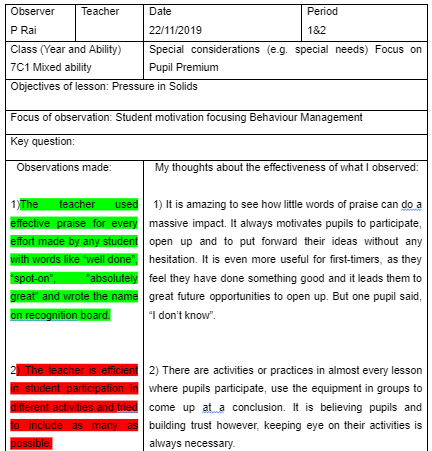


Appendix 2 Observation 2


Appendix 3 Observation 3
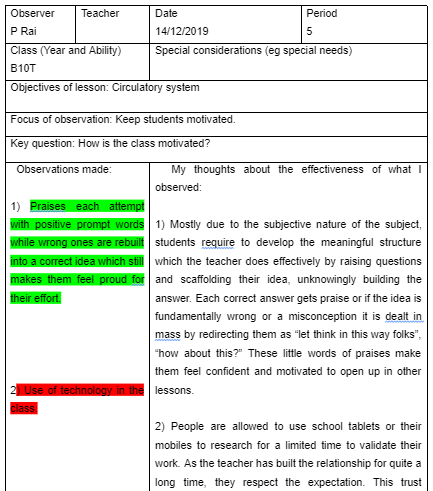
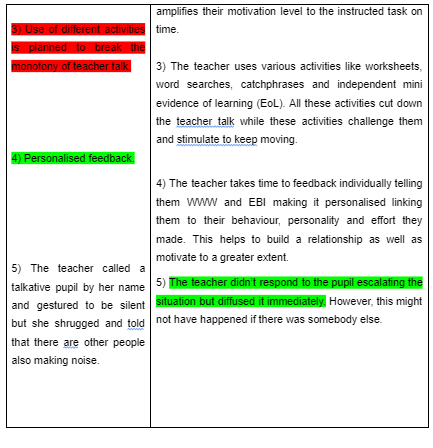
Appendix 4 Observation 4
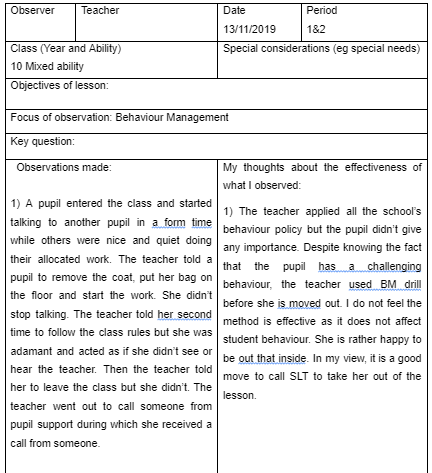
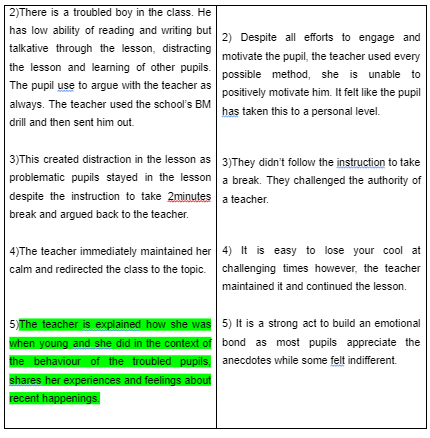
- 24/7 Customer Support
- 100% Customer Satisfaction
- No Privacy Violation
- Quick Services
- Subject Experts



